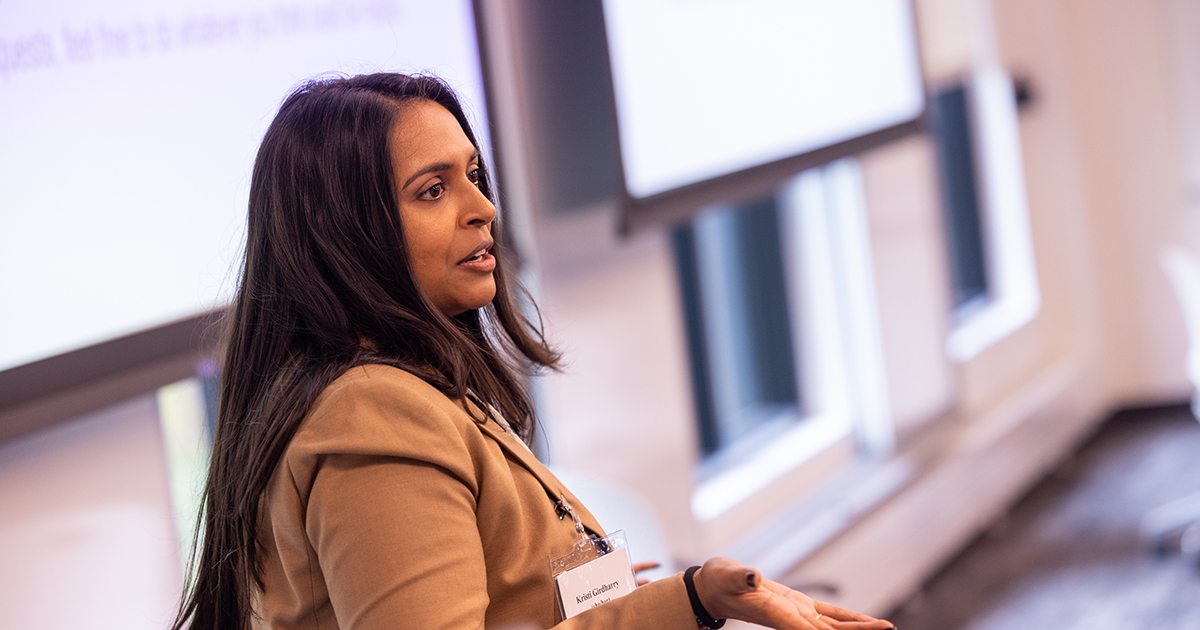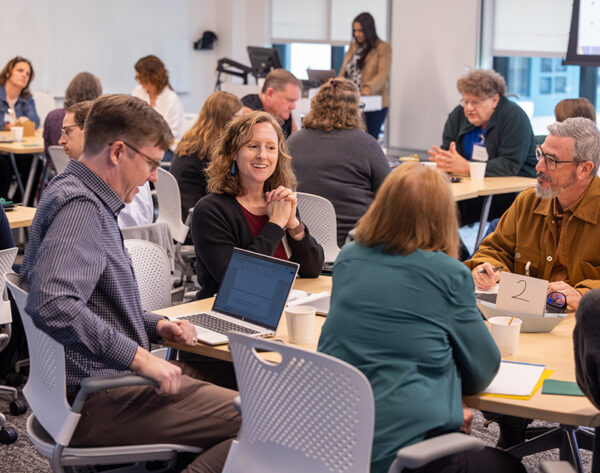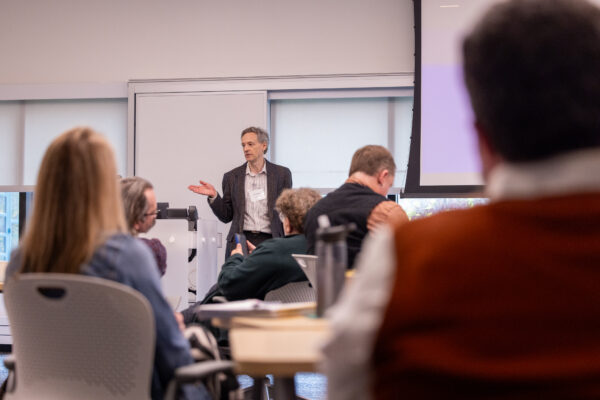AI in Action: How Babson Students Use Technology to Transform Research and Business

Empower. Delve. Foster.
Marie-Elena Gerety ’24 listed those three words as an example of the telltale text that can expose a student paper as written by generative artificial intelligence. But, Gerety was quick to point out, students have moved far beyond using AI as a simple shortcut to finish homework.
For example, Gerety launched an AI startup, Pluck, aimed at aiding those with trichotillomania, a condition that causes people to repeatedly pull out their hair. Using gesture-recognition software, her tool alerts users to potentially harmful movements.
“I’m very grateful to AI for not only helping me start my company, but I also have my eyebrows back,” Gerety said with a laugh. She credited Babson’s supportive AI culture and resources for helping her transform a personal challenge into a growing business.
Gerety and seven other Babson students provided firsthand accounts of how they use AI as part of a unique, daylong Babson symposium addressing the use of AI in writing and research across higher education. Kristi Girdharry, a Babson associate teaching professor and director of the Writing Center who explores the impact of AI on writing and research at Babson’s AI lab The Generator, created the event to provide a format for higher education writing instructors to discuss the revelatory tool and its impact on research and writing.
Attendees, representing more than 30 higher education institutions including Harvard, MIT, and Northeastern University, sat rapt as Babson students discussed their use of AI to support creativity, accelerate research, improve communication, and enhance productivity.
For Jiaxin Gan ’26, whose first language is Chinese, AI has improved her ability to communicate complex ideas.
“As an international student, it’s really hard for me to ensure I have the right grammar while also making sure I’m writing like a native English speaker,” Gan said. The capability, she said, eases the communication barrier faced by many international students and enables her to convey ideas in a way that resonates with a wider audience.
How Students Really Use AI
For Spencer Karns ’26, AI has transformed his research methods. “It’s like pouring liquid starter on everything I do,” he said, describing how AI helps him accelerate both academic and personal projects. With AI, Karns said he can ideate at “stream-of-consciousness speed,” a capability he believes would otherwise take years to develop.

AI also has been a game-changer for creativity, according to Vaness Reece Gardner ’26. An artist at heart, Gardner highlighted the ways generative tools allow him to produce high-quality visuals and prototypes in record time. “It’s like the internet or electricity,” he said of AI. “I’m just trying to take it by the horns, especially with tools that can generate text-to-image or even text-to-3D designs.”
On the entrepreneurial side, Rania Ishoof ’28 praised Babson’s culture of innovation, explaining how AI allows her to handle multiple roles in one project. “Instead of searching for co-founders, I can leverage AI tools to work as a one-person team,” she explained. It enables her to automate workflows and craft detailed business plans, which is crucial for budding entrepreneurs.
Linhao Jiang ’26, a student photographer, described the power of AI-enabled Adobe tools, saying he can remove unwanted objects from photos seamlessly. Jiang, who also studies coding, admits he also uses AI to save time.
“I want to have more free time in my life. Let’s say it’s Friday night, would you rather sit in front of a computer doing coding, or go out with friends and eat sushi?” Jiang asked. He added that AI helps to bridge gaps in his technical skills, such as translating code syntax between programming languages. “It’s like having a tutor by my side whenever I need it,” he said.
Elizabeth Tran ’28 said AI tutoring platforms even helped her affordably prepare for college. With AI-powered tutoring, Tran secured a scholarship and academic support she might not otherwise have accessed.
“AI has opened resources I didn’t have,” Tran said, acknowledging the unique role AI plays in leveling the playing field for students from various backgrounds.
Generative AI in Higher Education
Before the student panel, higher education instructors at the symposium discussed different initiatives and challenges with generative AI at their respective institutions. Some institutions ban students from using AI for writing assignments altogether, while others have a mix of different AI policies throughout the university.

Girdharry encouraged attendees, sitting in cross-institutional groups of five to seven people in the Lorber Family Classroom at Babson’s Herring Family Entrepreneurial Leadership Village, to brainstorm solutions and share promising practices.
“What are some things we can work on today that might help?” Girdharry asked.
“I think a student panel is an amazing idea, and I’d love to get that going at Bunker Hill,” said Ashley Paul, an English professor at Bunker Hill Community College. Another instructor had tried to organize a student panel at a different institution, but students didn’t dare speak publicly because of the negative connotations surrounding generative AI.
Attendees also heard from Carl Quillen, a principal applied scientist at Microsoft, who spoke earlier in the day about the evolution of ChatGPT and his 28-year career working with language-related machine learning.
But instructors at the symposium, created as part of the Generator’s mission to teach, share, and incorporate technology among higher education institutions, were most excited to hear from Babson’s students. Toward the end of the conversation, moderated by Babson assistant professor Stephen McElroy, one attendee asked students to share what they wish faculty members knew about AI.
“I think there’s an assumption that students are just going to use AI to write everything for them, which, to be fair, can happen,” Amelia Smith ’26 said. “But just saying ‘No AI whatsoever,’ on different writing assignments almost harms learning. I wish professors knew how AI could be used for research.”
Gardner added, “It’s not about shortcuts; it’s about learning how to use these tools wisely.”
Posted in Community, Entrepreneurial Leadership





